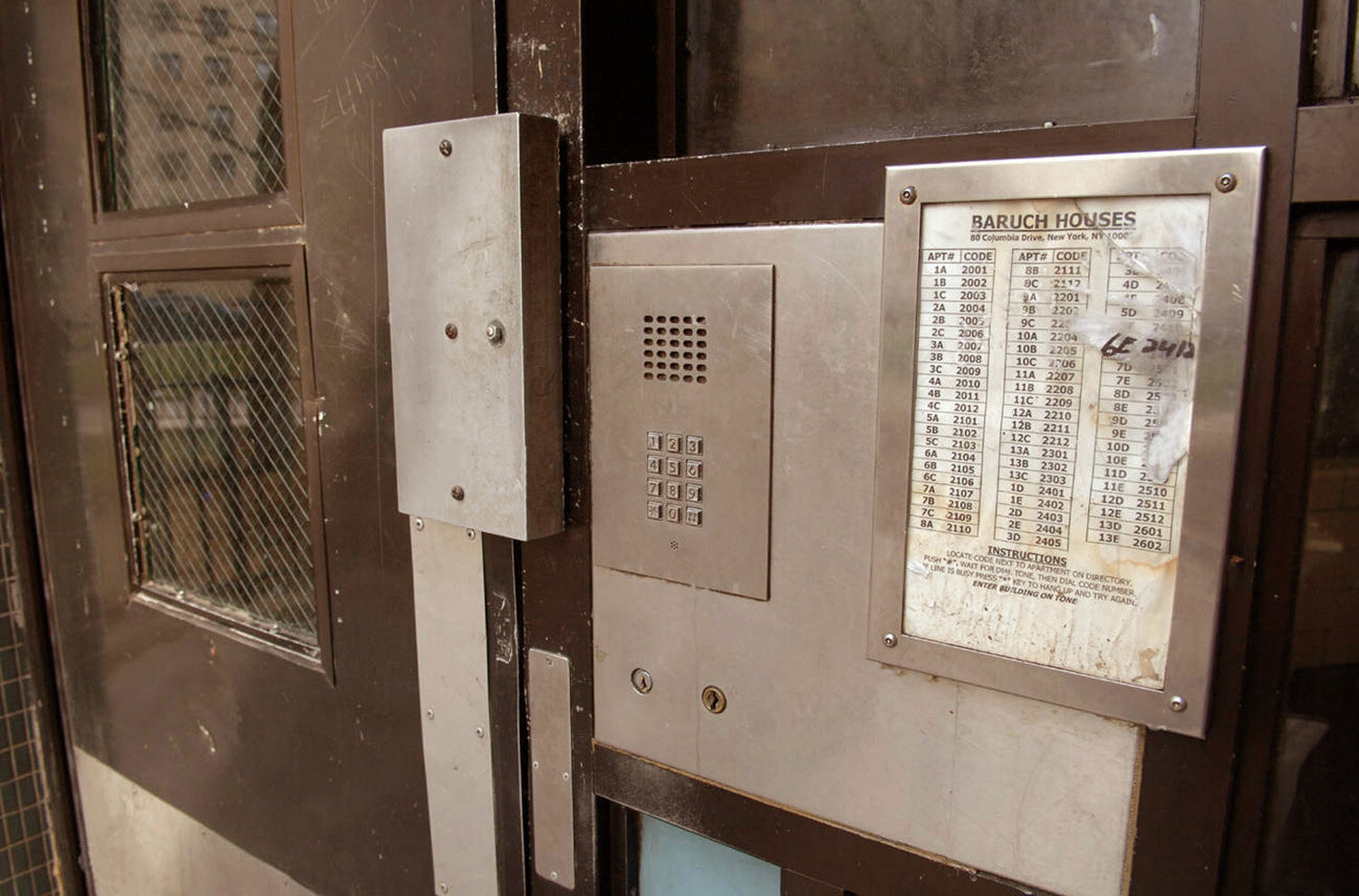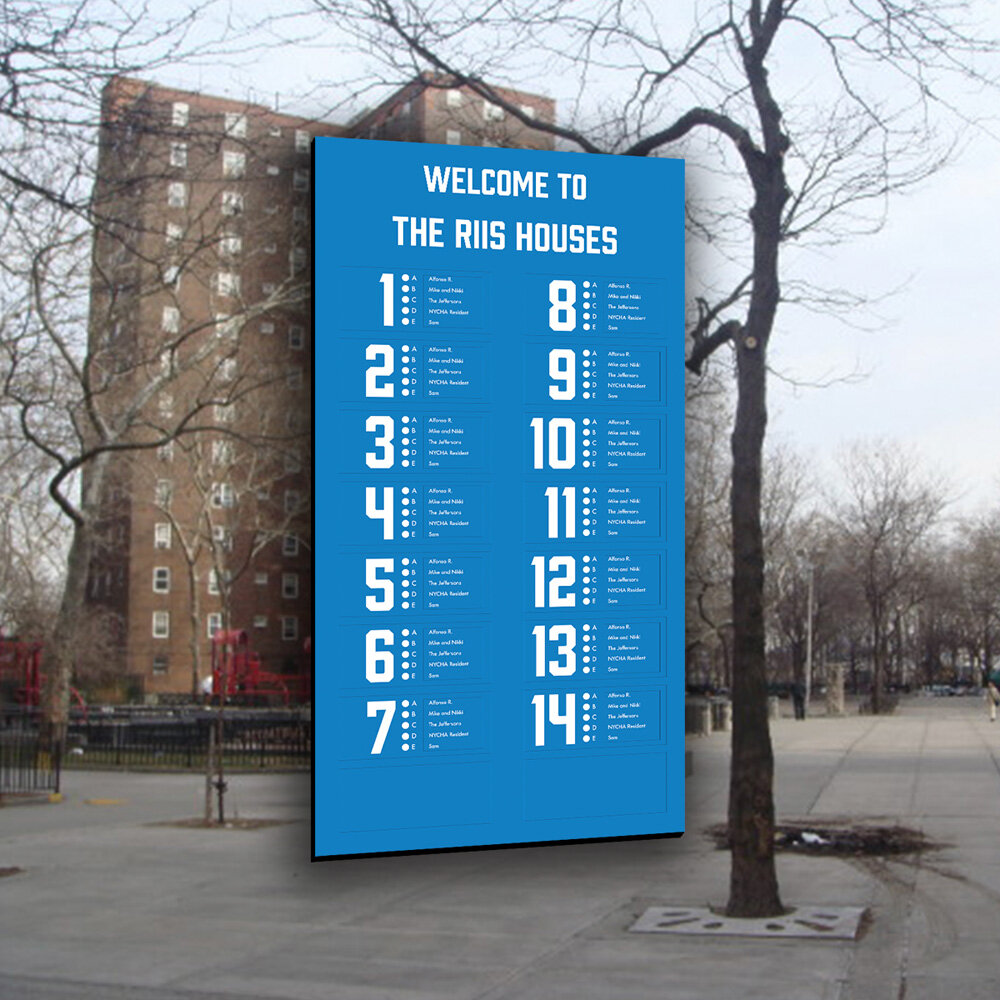New York City Housing Authority
Village Buzzers
A modular guest entry system for public housing in New York City.
New York City Housing Authority
A modular guest entry system for public housing in New York City.
There are currently
326
public housing developments in New York City, providing affordable housing for an estimated
600,000
New Yorkers.

There are currently 326 public housing developments in New York City, providing affordable housing for an estimated 600,000 New Yorkers.
That means that there are more New Yorkers living in public housing than there are people living in the
entire city
of Atlanta. Or Miami. Or Baltimore. Or Milwaukee.

That means that there are more New Yorkers living in public housing than there are people living in the entire city of Atlanta. Or Miami. Or Baltimore. Or Milwaukee.
Unfortunately, due to a shoe-string budget, and the need to work across a wide variety of building layouts and sizes, the NYCHA user experience can be pretty dismal.

Unfortunately, due to a shoe-string budget, and the need to work across a wide variety of building layouts and sizes, the NYCHA user experience can be pretty dismal.
*New York City Housing Authority. Pronounced “nigh-cha.”
The current buzzers have many problems.
First, they are just plain ugly to look at, the stainless steel feeling institutional and cold.
They are also very impersonal. Residents are represented by numbers and "codes," stripping them of all identity, and missing an important opportunity to help create a sense of community and pride within the building.
From a functional standpoint, they are hard to use. The visitor must first read the "instructions," then browse a registry with a total lack of hierarchy to find the apartment they want to buzz. Finally, they have to enter a code into a pin pad, forcing them to either quickly memorize a number or glance back and forth like a maniac.

The current buzzers have many problems.
They’re ugly.
They’re impersonal, representing residents with code numbers and stripping them of all identity.
They’re hard to use, requiring the user to browse a registry, locate a code, and quickly memorize it before punching it into a keypad.
My solution.

Shown above is a real prototype which I designed and constructed myself.
My first goal in redesigning the buzzer was to make it more visually appealing. By utilizing different materials and color, we have gone from an institutional stainless steel to a smooth acrylic in a fun shade of cyan. I’ve also cleaned up the look by organizing some of the information it holds into more cohesive sections.
I also thought it would improve the experience for both visitor and resident if each apartment was allowed its own button, and help foster a sense of community if each unit was able to display a name by their button.
The redesign is broken up floor by floor. If someones wants to buzz apartment 4A, they quickly locate the large 4 and press the button next to the letter A.
No more hunting for codes. And it all works and remains feasible due to the modular construction of the buzzers.

The component above is an individual unit known as a “floor module.” NYCHA building have a maximum of 5 apartments per floor—this particular unit is for a building that has the maximum amount of apartments on that floor.
As you can see, also included in the redesign is a panel that shows each resident’s name next to their button. This panel holds a removable slip of paper with the resident names, and can be printed on an inkjet printer at a central NYCHA office.
If a resident wishes to be anonymous, they can list themselves as “NYCHA Resident.” They can also use nicknames if they choose to personalize their identity—it’s all up to them.

The Village Buzzer system has to have the same effective breadth that the original system had. Meaning, any install of the Village Buzzer system must work across all 326 public housing projects in New York City.
Each Village Buzzer unit is made up of an empty, pre-wired “skeleton” with 17 slots: one large slot to accommodate the name of the housing project, and 16 smaller slots to allow for “floor modules.” (There are no NYCHA buildings with more than 16 stories.)
For building with fewer than 16 floors, blank modules can be installed.
Shown here is a real prototype which I designed and constructed myself.
My first goal in redesigning the buzzer was to make it more visually appealing. By utilizing different materials and color, we have gone from an institutional stainless steel to a smooth acrylic in a fun shade of cyan. I’ve also cleaned up the look by organizing some of the information it holds into more cohesive sections.
I also thought it would improve the experience for both visitor and resident if each apartment was allowed its own button, and help foster a sense of community if each unit was able to display a name by their button.
The redesign is broken up floor by floor. If someones wants to buzz apartment 4A, they quickly locate the large 4 and press the button next to the letter A.
No more hunting for codes. And it all works and remains feasible due to the modular construction of the buzzers.
Shown at the right is an individual unit known as a “floor module.” NYCHA building have a maximum of 5 apartments per floor—this particular unit is for a building that has the maximum amount of apartments on that floor.
As you can see, also included in the redesign is a panel that shows each resident’s name next to their button.
If a resident wishes to be anonymous, they can list themselves as “NYCHA Resident.” They can also use nicknames if they choose to personalize their identity—it’s all up to them.
The Village Buzzer system has to have the same effective breadth that the original system had. Meaning, any install of the Village Buzzer system must work across all 326 public housing projects in New York City.
Each Village Buzzer unit is made up of an empty, pre-wired “skeleton” with 17 slots: one large slot to accommodate the name of the housing project, and 16 smaller slots to allow for “floor modules.” (There are no NYCHA buildings with more than 16 stories.)
For building with fewer than 16 floors, blank modules can be installed.
An assortment of modules, including Building Nameplates, Floor Modules, and Blank Modules.
Assembly of a Village Buzzer unit is very simple and only requires use of an 8mm nut driver. Each module is prewired and simply plugs in to the wiring harness of the empty body.
Looking at the prototype from the rear, you can see how each module has an orange female electric connector that snaps into a corresponding orange female connector that is pre-wired into the blank skeleton.
The small blue boxes on the back of each module (soldered into the circuit board) are dip switches, which allow buttons to be turned off for apartment buildings that have fewer than 5 units per floor.
At the top is the bell, specifically chosen to provide a friendly, playful tinkling rather than a harsh buzzing tone.
At the bottom of the assembly, you can see three blank modules that don’t have any wiring at all.

Assembly of a Village Buzzer unit is very simple and only requires use of an 8mm nut driver. Each module is prewired and simply plugs in to the wiring harness of the empty body.
Looking at the prototype from the rear, you can see how each module has an orange female electric connector that snaps into a corresponding orange female connector that is pre-wired into the blank skeleton.
The small blue boxes on the back of each module (soldered into the circuit board) are dip switches, which allow buttons to be turned off for apartment buildings that have fewer than 5 units per floor.
At the top is the bell, specifically chosen to provide a friendly, playful tinkling rather than a harsh buzzing tone.
At the bottom of the assembly, you can see three blank modules that don’t have any wiring at all.
Click on the image above to go to a larger view.

16 Floors — East Harlem

7 Floors — Rockaway Beach

5 Floors — Red Hook

6 Floors — Bed-Stuy

14 Floors — East Harlem

6 Floors — Brownsville

13 Floors — Lower East Side

14 Floors — East Village
16 Floors — East Harlem
7 Floors — Rockaway Beach
5 Floors — Red Hook
6 Floors — Bed-Stuy
14 Floors — East Harlem
6 Floors — Brownsville
13 Floors — Lower East Side
14 Floors — East Village
